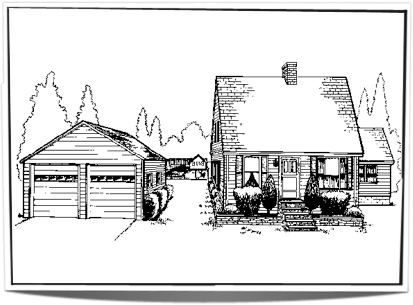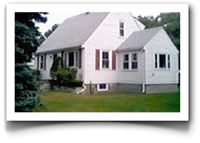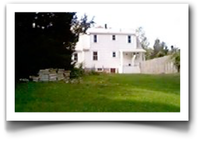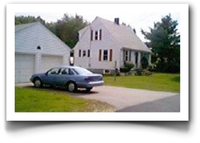
This was an artists view of the property which was created from look at a number of different photographs. The artists never actually saw the buildings but his rendering gave the best overall view of what it look like.
A story that I enjoy telling is one where I encountered my own "Civil Action" in my life. "A Civil Action" is both a book and a movie about water wells becoming polluted with a variety of volatile organic compounds including chlorinated solvents within the town of Woburn, Massachusetts during the late 1960's, 1970's and the health and legal consequences that were triggered by those events.
In 1986 my wife and I purchased a property in South Hingham, Massachusetts. The property was a 3 bedroom, modest cape on about 1 acre of land. It had a built in swimming pool, very private location and, for those of you who may know Hingham, South Hingham was still undeveloped to the point where houses still depended largely on private wells for potable water. Due to employment movement and relocation in 1988 I ended up buying my present home in Wayland and (because the state housing market was starting to price collapse), I decided to take the leap and become a landlord. The Hingham property was rented starting in the summer of 1988.
In 1993 I received a phone call from my tenant telling me that a representative from the Sun Oil Company (Sunoco) wanted to meet with me at the property to discuss the 'well situation'. This was the first time I became aware that there could be any problem with the ground water. I came away from that meeting with the knowledge that in 1985 there was a underground storage tank breech at the Sunoco gas station at 93 Derby Street and that unleaded gasoline (with the primary VOC being MTBE - an unleaded gas additive) had washed through the groundwater and had diffused far and wide. My street was right in that path of that event and the groundwater, for a number of years, had significant levels of MTBE. By 1993 the levels were in the single digit parts per billion (PPB) and these were levels that were accepted by the Mass DEP as being water potable. The fact that the levels were so low was good news, but the bad news was the groundwater had been significantly hit and the real estate reputation of my property and my neighborhood was seriously damaged. I was about to be a landlord for a very long time.
Sunoco, under orders from the Mass DEP installed carbon filtration systems in each of the homes on my street and underwent a program by which they would test the influent and effluent water and perform, each month, a 524.2 VOC water test looking for a wide variety of volatile compounds. In the case of my property, I would usually get hits of MTBE in the very low, single digit range. But it wasn't going to zero.
Other properties near mine had worse situations. The famous cleaning fluid compounds of "A Civil Action", the chlorinated solvents were present in the groundwater of homes adjacent to mine. The mystery was their origin and it wasn't at all clear that the gas station was the source of these 'non gasoline' compounds. I waited from that initial Sunoco / Tenant meeting in 1993 until the spring of 1995 to gather data and research the Mass DEP records, the Hingham Board of Health and then decided to take some actions. My property was damaged and I felt that if I wasn't going to do something about this... nobody else would.
On the Easter week of 1995 I organized a meeting of residents of the surrounding streets, including my street, at the Hingham High School and with a local 'pro-bono' lawyer present I showed (using transparencies on an overhead projector) water tests at dozens of homes from 1985 to 1995. Many people learned that night that their groundwater had actually been affected by the gasoline leakage event of 1985 and that they had knowledge which caused them to be directly involved. This strategy effectively shut down the real estate buy/sell market in that part of Hingham for a number of years. Effectively, what was the problem of my street now became the problem of many streets. When you want to pressure a deep pocket polluter, you need to have critical mass. (Turned out, we didn't use that attorney - we settled it ourselves... read on).
The research that I performed showed me that there were multiple sources of pollution. BTEX (basic gasoline) from at least two separate gas stations (one existing and one not), MTBE (the unleaded additive) from one gas station that was still there, and chlorinated solvents from a pre-existing business at the Hingham Shopping center. That business was a dry cleaners. The expansion of this knowledge now brought into play an interaction of not just an oil company but also land owners, leasing agents and former business owners, all of whom were pointing the finger at each other.
In the summer of 1995 I organized a public involvement process (PIP) which is a Mass DEP instrument by which the citizens can haul the 'alleged' polluters into the open and cause them to make presentations an to cause them to answer hard questions. I will never forget that afternoon and night and the courage I had to muster to lead the charge and ask those very difficult questions. What I haven't said here is that the strategy was to PIP only the shopping center entities and not Sunoco.... why? Sunoco was involved in testing and the solution and, in fact, acted as an educative entity to help me discover who else could be involved. But Sunoco certainly did not want to be PIP'ed. Certainly not after that meeting.
It was that PIP which caused Sunoco to offer to my neighborhood group a solution. The best news about this Hingham "Civil Action" is that nobody ever got sick from the pollution events... at least as far as I could tell. So the solution that I wanted was to restore the neighborhoods fresh and clean water supply and therefore, the property values to where they should be.
The Sun Oil Company came through. Sunoco offered my group a deal which provided for the running of city water pipes from the closest hook up point and connecting up many properties along the way. In late 1996 the water pipes were in place and my specific property then had two sources of water. The city water and a newly drilled bedrock well because the original one had failed for non-pollution reasons (but that’s another story).
I kept the property for another 7 years and finally sold it (with full disclosure) to a real estate agent who lived locally and who contacted me directly about it. This story is so much longer and perhaps I might write a book about it someday. But this was my first involvement in public and governmental organization. Perhaps this was the event that gave me any hint of an idea that I could run for Selectman in Wayland.
Thanks for listening to this one.


